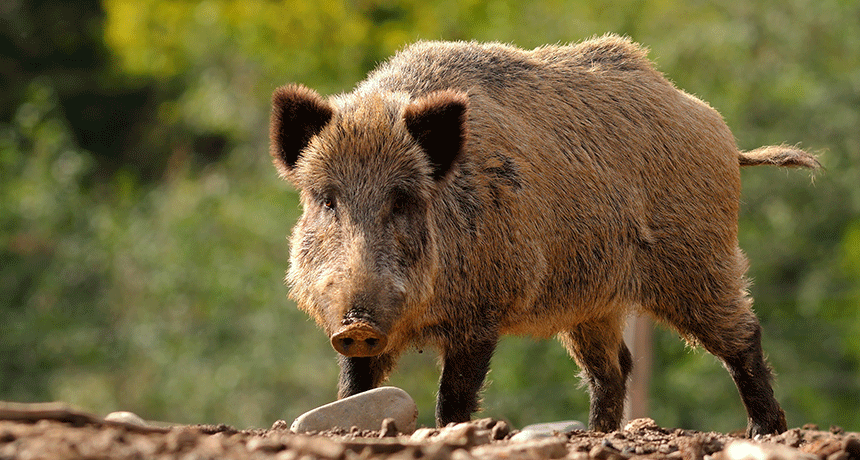Author: Stephen Ornes / Source: Science News for Students

The call came one morning in the spring of 2013. The cemetery was a mess.
Charlotte Watson remembers it clearly. She works in the courts in New York City. She also runs an organization that protects a historic cemetery in rural Texas, where she grew up. Named Willow Wild, this cemetery sits on 36 hectares (90 acres) in Bonham. The site is about 130 kilometers (80 miles) northeast of Dallas. Someone in Bonham who regularly visited the cemetery was the first on the scene.
“Something terrible had happened,” Watson recalls — wild pigs!

They had barged in and uprooted wide patches of grass. It looked like someone had ripped out the grass and tilled the soil. No grave markers were knocked over, but “it looked really bad,” says Watson. “You couldn’t imagine [the grass] would grow back.”
For the next few weeks, wild pigs slept under the surrounding trees by day and slipped into the cemetery by night: They came to root in the soil for grubs. These thick white worms, which would grow up to become beetles, live several centimeters (a few inches) below the soil surface.
The invaders weren’t going to leave quickly on their own. Watson and her group had to face some tough questions about how to deal with these far-from-benign swine.
Texas is hardly alone in facing marauding pigs. These wild swine can be found in nearly every U.S. state. They’ve also been spotted in Canada, and many cross the border from Texas into Mexico. In the United States, they have become concentrated in southeastern states. They also wreak havoc in other countries, including the United Kingdom and Australia. In Germany, hordes of pigs dig up gardens in the suburbs of Berlin.

Wild pigs cause some $1.5 billion in damage every year in the United States, mostly to crops, according to the U.S. Department of Agriculture (USDA). They also pose a health hazard. Wild pigs carry at least 30 diseases and 37 parasites (organisms that live and feed on a living host). Some of these diseases and parasites can spread to other animals. They can also infect people who eat or breathe the germs. And when cornered, wild pigs can, though rarely, attack people. Last December, for instance, a feral pig attacked the German hunter who had shot it. The man would later die.
Wildlife biologists around the world want to understand these feral swine to halt the menace. They’re tracking the animals to understand their behavior and predict where they’ll go. Researchers are testing new traps, including some that send real-time video to smartphone apps.
Stopping the pigs is difficult, in part, because they’re canny. “They’re one of the smartest animals on the planet,” notes wildlife biologist Alan Leary. He works for the Missouri Department of Conservation in the state’s capital, Jefferson City. “We have to continually come up with new techniques to stay ahead of them,” he says.
Right now, the pigs are winning.
Swine invasion
They go by many names: wild pigs, wild hogs, feral swine, feral pigs and wild boars. But they’re all Sus scrofa, a pig species native to Europe, Asia and North Africa.
A group of wild pigs can devastate corn or soybean fields overnight. The swine can shred riverbanks and wreak havoc near cities, even in people’s yards. They destroy landscaping. The muddy mess they leave behind often looks like the crater from a bomb.
In the last few decades, the pig menace has worsened in the United States because the animals don’t have any natural predators. What’s more, people haven’t found an effective way to stop them. In the first week after the fastest highway in the United States opened — south of Austin, Texas — three cars collided with wild pigs. And then there was that F-16 fighter jet, back in 1988, that collided with feral pigs on a Florida runway. The pilot ejected to safety. His $16 million jet? Destroyed.

There’s a term to describe critters like wild pigs: invasive species. These organisms don’t cause problems in their natural habitats. But when people have introduced them into a new environment, either on purpose or by accident, they tend to cause problems. Sometimes big problems. Invading plants and animals can quickly gobble up available resources and make it harder for other species to thrive.
Invasives might outcompete native species, causing the natives to decline. Or the invasive species could damage crops and natural areas, such as woodlands. Invasive insects might kill trees, leaving a forest more likely to burn. One 2005 study estimated that invasive species cause $120 billion in U.S. damage each year.
Pigs are not native to North America. Spanish settlers who colonized Florida in the 14th and 15th centuries brought along swine. For the first couple hundred years, populations of these animals stayed small and contained. They rarely roamed beyond the Florida panhandle.
Then hunters became interested in wild pigs toward the…
The post Can anything stop the big pig invasion? appeared first on FeedBox.